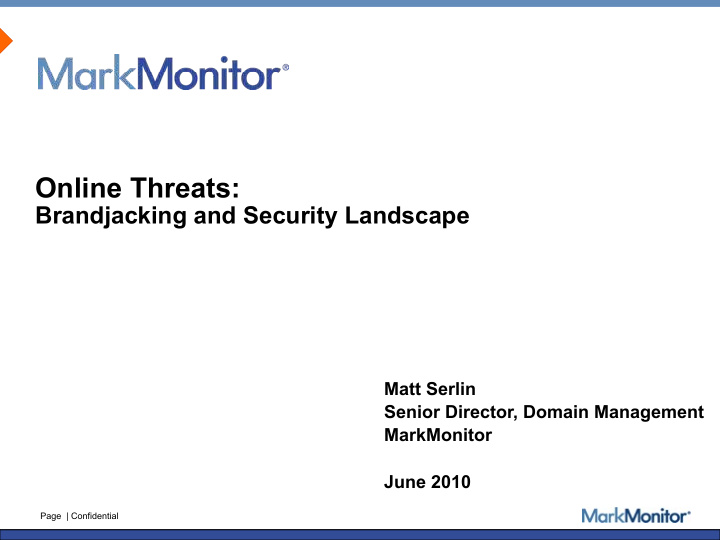



Online Threats: Brandjacking and Security Landscape Matt Serlin Senior Director, Domain Management MarkMonitor June 2010 Page | Confidential
Agenda About MarkMonitor Brandjacking 2009 Year in Review • Brand abuse trends • Phishing statistics Recent Domain Name Security Breaches • Understanding the Vulnerabilities • Mitigating the Risks Domain Security Best Practices Page | Confidential
About MarkMonitor Experience and expertise • Founded in 1999 - 10+ years experience protecting brands • ICANN accredited registrar • Unique corporate-only approach Customer-focused market leader • 50+ of Fortune 100 • 5 of 6 most trafficked Internet sites under management Global Presence • San Francisco, Boise, London, New York, Los Angeles, Washington DC Most Trusted Corporate Domain Name Registrar Page | Confidential Page 3 | Confidential
Brandjacking 2009 Year in Review Page | Confidential
Brandjacking Index Overview Tracking 30 of the most popular brands as ranked by Interbrand Weekly sampling of more than 225,000 potential brand abuse incidents conducted throughout 2009 for the overall brand analysis Nine vertical segments (Automotive, Apparel, Media, Consumer Packaged Goods, Consumer Electronics, Pharmaceutical, Food & Beverage, High Tech and Financial) for the overall brand analysis Spam feeds from leading international Internet Service Providers (ISPs), email providers, and other alliance partners to detect phishing and other fraud Page | Confidential
Incidents of Abuse Across Top 30 Brands Page | Confidential
Quarterly Brand Abuse by Industry Page | Confidential
Geographic Location of Sites Hosting Abuse Page | Confidential
Phishing Trends Page | Confidential
Record Levels of Phish Attacks per Organization Page | Confidential
Domain Name Security Issues Page | Confidential
Domain Name Security Breaches on the Rise Hackers now recognizing that domain security can be breached Registries and registrars are exploited as technical and social vulnerabilities are uncovered Attacks against domain registrants are resulting in compromised credentials Page | Confidential
Various Vulnerabilities Exploited Page | Confidential
Social Engineering Attacks Registrars need to evaluate how weak their human links are • Many are lax enough to be easily victimized by simple social engineering tricks • In many cases, a user ID and password is all that is needed Page | Confidential
Phishing Attacks Domain administrators can be tricked by phishing • Customers of Network Solutions were sent an email asking for their IDs and passwords • It is believed that one respondent was an employee of CheckFree Information obtained gave the phishers the opportunity to redirect CheckFree’s customers to a rogue server located in the Ukraine for 5 hours Page | Confidential
Malware The most recent development in domain name attacks is the targeted deployment of malware, such as keyloggers sent to corporate domain name administrators Keyloggers track logins and passwords for corporate domain name management portals With this credential information, scammers can • Unlock and hijack domains • Update name servers, or even change DNS settings • Effectively take sites down • Infect unsuspecting website visitors with malware Page | Confidential
Targeting Domain Related Vulnerabilities Hacker Infrastructure Breaches Process Exploits Registry Social Engineering Attacks Social Engineering Attacks Infrastructure Breaches Domain Hijackings DNS Infrastructure Breaches Provider Registrar Domain DNS Administrator Administrator Credential Theft Identity Theft Page | Confidential
Securing Domain Related Vulnerabilities Hacker MarkMonitor Early Detection Ability to Quickly Respond Registry Operational Policies Operational Policies Hardened Infrastructure Third-Party Evaluations DNS Two-Factor Authentication Hardened Infrastructure Provider IP Address Restrictions Two-Factor Authentication IP Address Restrictions Portal Locking Registrar Registry Locking Domain DNS Administrator Administrator Portal Locking Two-Factor Authentication Registry Locking IP Address Restrictions Page | Confidential
Mitigating the Risks – What we tell Clients Page | Confidential
Consolidate Domain Names Gain visibility into entire portfolio and protect against loss due to expiration, disgruntled employees or erroneous changes Compare trademark registrations against domain registrations Utilize Reverse Whois to uncover domain names by searching registrant name, nameservers, e-mail addresses and phone numbers Identify and contact individuals within the organization who are registering names: • Legal, IT, Marketing, E-Commerce, subsidiaries, divisions, etc. Page | Confidential
Utilization of Hardened Registrar Ensure that your registrar employs a “hardened” portal – one that employs constant checks for security and code vulnerabilities the same way the web security team does for your websites The registrar must have a track record of being able to stay on top of new exploits, and of researching and understanding new vulnerabilities In addition, the registrar must be able to demonstrate use of strong internal security controls and best practices. Page | Confidential
Registrar Domain Locking An elevated locking mechanism, sometimes referred to as a “Registrar Lock” or a “Super Lock,” that essentially freezes all domain configurations until the registrar unlocks them as the result of the completion of a customer-specified security protocol Companies can determine the level of complexity associated with their protocol and domains are made available for updating through the portal only when these security protocols are accurately completed This extra level of security should be applied to your most mission-critical domains such as transactional sites, email systems, intranets, and site-supporting applications Page | Confidential
Registry Domain Locking “Registrar Locking” can still be exploited by an attacker who updates name servers, thereby redirecting customers to illegitimate websites without transferring actual control of the domain from one registrar to another To combat this, another step is “registry locking,” or “premium locking,” which makes the domain unavailable for any updates at all This method of locking is currently available only for .com and .net registrations Where possible, Registry Locking should be applied to domains used for transactional sites, email systems, intranets, and site-supporting applications Page | Confidential
Domain Security Best Practices Checklist Employ two-factor authentication for accessing domain management portal Employ two-factor authentication for accessing DNS management portal Never share login credentials for your domain or DNS management portals Lock mission critical domains at the registry level, where possible Disable ability to edit core domains for all users Continually manage and review secondary user accounts Require mandatory password updates Implement IP access restrictions Receive automated notifications of every domain name update Utilize a corporate-only, hardened registrar Page | Confidential
Questions? Page | Confidential
Recommend
More recommend